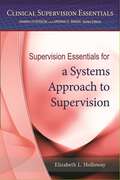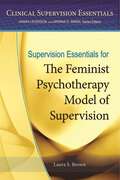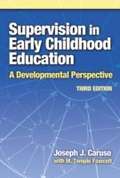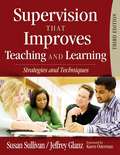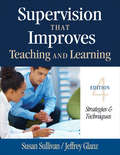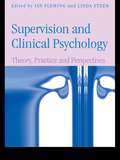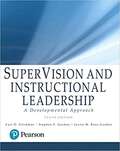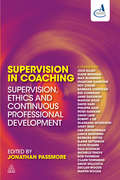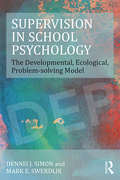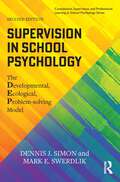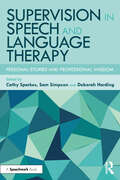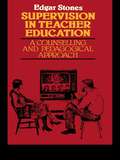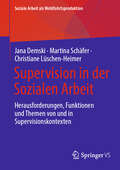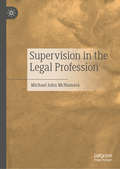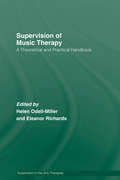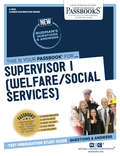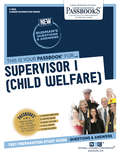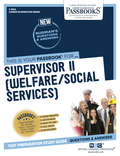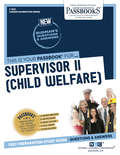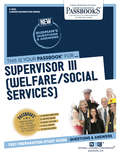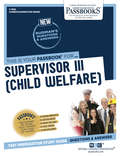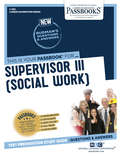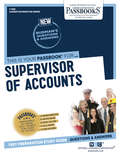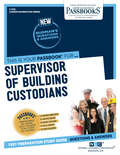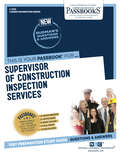- Table View
- List View
Supervision Essentials for a Systems Approach to Supervision (Clinical Supervision Essentials Series)
by Elizabeth L. HollowayA systems approach to supervision conceptualizes the supervisory relationship as consisting of several key dimensions, or systems, which interact in subtle ways across various contexts. These systems include the client, the trainee, the supervisor, the functions and learning tasks in supervision, and the professional institution in which the supervision process is taking place. This book demonstrates the various roles supervisors play, from monitor and advisor, to role model, consultant, and mentor, and offers clear, compelling demonstrations of competencies including counseling skills, case conceptualization, ethical practice, intra and interpersonal awareness, and self-evaluation.
Supervision Essentials for the Feminist Psychotherapy Model of Supervision (Clinical Supervision Essentials Series)
by Laura S. BrownWhile feminist therapy has grown in stature and recognition in the last few decades, comparatively little has been written about supervision and consultation from a feminist standpoint. In this book, the latest in the Clinical Supervision Essentials series from APA Books, Dr. Laura Brown remedies this deficit by presenting a theoretically-grounded, yet practical approach to supervision based on the principles of feminist psychotherapy. This volume offers a framework for translating feminist therapy constructs — including recognizing the impact of systemic hierarchies, and thinking critically about dominant cultural norms in the practice of psychotherapy — into the supervision setting. Incorporating practices derived from multicultural, queer, and other critical psychologies, feminist therapy supervision challenges trainees and supervisors alike to engage with difficult questions about the presence of bias, and ways in which power distributes itself in the context of education, psychotherapy, and supervision itself. Includes a synthesis of the literature on feminist therapy and theory, as well as case examples and practical advice for resolving common supervision problems. The book also offers close analyses of the author's consulting session documented in the DVD Feminist Therapy Supervision, also available from APA books.
Supervision In Early Childhood Education: A Developmental Perspective
by Joseph J. Caruso M. Temple FawcettEvery early care and education program deserves a qualified and competent supervisor. This pioneering text continues to address the special needs of administrators and staff to help them expand and improve their supervisory skills. The first to provide guidelines and practical suggestions for staff training and development in early childhood settings, this classic volume is still the best choice for those supervising staff from a wide variety of educational and cultural backgrounds.
Supervision That Improves Teaching and Learning: Strategies and Techniques (3rd edition)
by Susan Sullivan Jeffrey GlanzIn this exciting, new edition of Supervision That Improves Teaching, the authors have taken their reflective clinical supervision process to a new level and focused on the demands that diversity and technology have placed on the supervision cycle. The authors recognize that if supervision of instruction is to be successful, we must address these needs. Therefore, they have built this third edition around the context of diversity within a technological environment. Our new scenarios describe teaching and learning dilemmas for English Language Learners. An additional case study also highlights English Language Learners within the context of â Critical Friendsâ groups and new observation tools center on the diversity of our schools. Finally, suggestions abound for use of the book within a technological environment â " from blogs and wikis to strategies for teaching a hybrid or completely online course. Sullivan and Glanz have also addressed the dilemmas of preserving meaningful supervision in an era of high-stakes testing and local, state, and national standards. The authors' reflective clinical supervision model encourages and prepares educators to be thoughtful collaborators in improving classroom instruction. And they have extended the options for teacher observation to a thorough but manageable set of tools for standards-based supervision. Outstanding additions to the third edition include:- New scenarios, cases and tools focus on the need for differentiated instruction for diverse and exceptional populations in the schools- Use of this book to evaluate the technological environment in schools in areas such as distance learning, online training, blogging and research- The authors draw a clearer distinction between evaluation and supervision in this 3rd edition- The timeline for the Supervision cycle in Chapter 1 has been updated and revised- Observation Instruments in Chapter 3 have been revised to be more reader and user friendly- Strategies and observation tools for maintaining reflective supervision in a standards-based environment. This bestselling approach continues to offer interpersonal tools for initiating and providing feedback on classroom observations, alternative approaches to common supervision practices, and the tools necessary for present and future educational leaders to develop dynamic conversations about learning between and among educators-the essence of what effective supervision is really about.
Supervision That Improves Teaching and Learning: Strategies and Techniques (4th Edition)
by Dr Susan S. Sullivan Jeffrey G. GlanzSecrets to supervising for instructional improvement! More than ever, effective supervision is vital to instructional improvement and this new edition of a bestseller pinpoints the process and techniques that matter most. Featuring 42 qualitative and quantitative observation tools, this new edition includes: New observation tools centered on diversity; New case studies on alternative approaches to supervision; A new chapter on creating transformational change; More on technology topics such as blogs and online courses; New scenarios highlighting English Language Learners and exceptional students; Emphasis on empowering teachers to reflect and improve upon instruction.
Supervision and Clinical Psychology: Theory, Practice and Perspectives
by Ian Fleming Linda SteenIncreased attention is now being paid to the role of supervision in both pre-qualification and post-qualification practice in clinical psychology in the UK. This definitive text addresses the issues of central concern to supervisors in clinical psychology. Senior trainers and clinicians draw on relevant research and their own experience, covering:* historical development of supervision and a review of worldwide literature on supervision* supervisory and therapy models* maximizing supervisory resources* supervisory training and effectiveness* cultural and gender issues in supervision* measuring the effectiveness of supervision* future perspectives for supervision in clinical psychology. Supervision and Clinical Psychology provides practical advice essential for clinical psychology supervisors, as well as those in psychiatry, social work and psychotherapy.
Supervision and Instructional Leadership: A Developmental Approach
by Stephen Gordon Carl Glickman Jovita Ross-GordonThe new edition of SuperVision and Instructional Leadership continues the innovative approach that has made it so widely popular, and includes a number of new content changes that bring the subject matter thoroughly up to date. Long recognized as a leading text in the field, this book calls for a collegial approach to instructional supervision; considers the knowledge necessary for successful supervision; discusses interpersonal skills, including different approaches to supervision and how they are used in developmental supervision; presents the technical skills of supervision, such as observing, assessing, planning, implementing, and evaluating; describes the technical tasks of supervision; and deals with the cultural tasks of supervision. A variety of learning aids ensure understanding of the theories and concepts. The Enhanced Pearson eText features embedded videos and chapter quizzes.
Supervision in Coaching: Supervision, Ethics and Continuous Professional Development
by Jonathan PassmoreCoaching is rapidly growing from a young, emerging profession to one that is becoming more established on a global scale. As professional coaching grows, so does the need for a more formulated approach to regulation, ethics and individual development. In order for coaches to develop their skills and knowledge they need to make continual professional development and supervision a core aspect of their practice.Published with the Association for Coaching, Supervision in Coaching examines how coaches can use a range of professional development tools to improve and develop their coaching. Written by a team of international coaching practitioners, it provides essential guidance on this increasingly key area of coaching practice. The authors provide advice on a range of topics, including approaches to supervision, managing ethical dilemmas, the role of regulation and licensing in coaching and the development of accreditation and professional standards.
Supervision in School Psychology: The Developmental, Ecological, Problem-solving Model
by Mark E. Swerdlik Dennis J. SimonSupervision is a core professional competency requiring specific training for the benefit of supervisees, clients, and the profession. Supervision in School Psychology: The Developmental, Ecological, Problem-solving Model examines specific factors that contribute to successful supervision in school psychology, including the integration of a developmental process of training, the ecological contexts that impact practice, and evidence-based problem-solving strategies. Written for graduate students, researchers, and professionals in the field of school psychology, this book provides thorough, specific, and immediately applicable methods and principles for supervisory practice. Featuring a diverse set of pedagogical tools, Supervision in School Psychology is an important resource for navigating the distinct challenges specific to the demanding and diverse core competencies associated with supervision in school-based settings.
Supervision in School Psychology: The Developmental, Ecological, Problem-solving Model (Consultation, Supervision, and Professional Learning in School Psychology Series)
by Mark E. Swerdlik Dennis J. SimonSupervision in School Psychology: The Developmental, Ecological, Problem-solving Model examines specific factors that contribute to successful supervision in school psychology, including the integration of a developmental process of training, the ecological contexts that impact practice, and evidence-based problem-solving strategies. Supervision is a core professional competency requiring specific training for the benefit of supervisees, clients, and the profession. Written for graduate students, researchers, and professionals in the field of school psychology, this book provides thorough, specific, and immediately applicable methods and principles for supervisory practice. Featuring a diverse set of pedagogical tools, Supervision in School Psychology is an important resource for navigating the distinct challenges specific to the demanding and diverse competencies associated with supervision in school-based settings. This second edition is significantly expanded and includes updated research on best practices in school psychology supervision. Expanded coverage and new chapters address system change and social justice advocacy skills, problems in professional competence, self-care, telesupervision, and deliberate practice. Maintaining DEP’s focus on the practical application of best practices, additional strategies are presented for teaching diveristy and multicultural responsiveness anchored in cultural humility. Supplemental case study material, supervisory process and reflection activities, tables, graphics, and practice-ready appendices as tools that illustrate best practices in supervision.
Supervision in Speech and Language Therapy: Personal Stories and Professional Wisdom
by Deborah Harding Cathy Sparkes Sam SimpsonSupervision plays a central role in supporting professional practice, practitioner wellbeing, clinical governance and client safety. This anthology, designed as a collection of possibilities rather than a definitive guide, offers a window into a less visible and rarely discussed aspect of practice. Contributors draw on first-hand encounters of supervision to share insights from both professional and public perspectives. These span practice contexts from pre-registration to qualified and into advanced clinical practice and management roles. The accounts include individual, team, multi-professional, independent and public sector experiences within and beyond the speech and language therapy profession. This book: Broadens the discourse and deepens understanding about supervision theory and practice Explores multiple formats and contrasting approaches to lay bare differences in the enactment of supervision as well as variations in underlying assumptions and real-life supervision challenges Holds a mirror up to diverse conversations about supervision across practice contexts and career points to broaden the scope of supervision possibilities Prompts exploration of new ways to engage with and benefit from supervision as an alternative or adjunct to existing, established approaches Demonstrates the clear return on investment in supervision at personal, departmental, service and organisational levels with both professional and public benefit Illustrated throughout with personal stories and professional wisdom, this book will interest students and practitioners at all stages of their career in speech and language therapy. In addition, it will appeal to other allied health and care professionals. This anthology aims to stimulate reflection on contemporary issues in supervision as well as individual, service and organisational supervision culture and practice.
Supervision in Teacher Education: A Counselling and Pedagogical Approach
by Edger StonesFirst Published in 2004. Routledge is an imprint of Taylor & Francis, an informa company.
Supervision in der Sozialen Arbeit: Herausforderungen, Funktionen und Themen von und in Supervisionskontexten (Soziale Arbeit als Wohlfahrtsproduktion #30)
by Martina Schäfer Christiane Lüschen-Heimer Jana DemskiDer Band diskutiert Herausforderungen, Funktionen, Themen von und in Supervisionskontexten Sozialer Arbeit, sowohl aus theoretischer als auch aus praktischer Perspektive. Es wird gezeigt, wie Supervision bei der Reduktion subjektiver Belastungen unterstützen und einen Beitrag zur Sicherstellung von Professionalität von Sozialarbeitenden leisten kann. Zudem werden gesellschaftliche Rahmenbedingungen in den zu erarbeitenden Bewältigungsansätzen für den Arbeitsalltag mit einbezogen.
Supervision in the Legal Profession
by Michael John McNamaraThis book is about supervision in the legal profession with a focus on the experience of novice lawyers. It is the first of its kind. Until now there have been a range of books dedicated to professional supervision in many disciplines, but not law. Supervision is an important link between formal university-based legal education and independent practice and is relevant to a range of contemporary legal practice issues including changes driven by technology, workplace culture, regulating law firm management, and well-being. This book aims to be scholarly and practical. It provides an overview of how supervision is positioned in the legal regulatory framework; it describes how supervision is conceived in the legal profession and practice management literature; and draws lessons from clinical legal education and other professional disciplines. By reporting on survey data, this book also provides insights into practitioners’ attitudes and perceptions about supervision in legal practice.
Supervision of Music Therapy: A Theoretical and Practical Handbook (Supervision in the Arts Therapies)
by Helen Odell-Miller Eleanor RichardsSupervision of Music Therapy discusses the theoretical bases underlying approaches to supervision in music therapy, as well as focusing on the distinctive aspects of music therapy supervision from both clinical and conceptual perspectives. In this book, leading music therapy supervisors and researchers demonstrate how music therapy trainees and practising clinicians can be supported through supervision, allowing them to develop confidence and authenticity in their work. Contributors discuss supervision of clinical work with a variety of patients in a range of settings, from special education to forensic psychiatry, including work in schools, children’s services and a dedicated music therapy centre. A chapter on the academic supervision of music therapists undertaking doctoral research is provided, together with an overview of the history and continuing development of the field. Supervision of Music Therapy contributes to current debates about approaches to supervision in music therapy, and offers the reader fresh perspectives on the subject, making this a book of value to practising therapists, supervisors and students alike.
Supervisor I: Passbooks Study Guide (Career Examination Series #C-1828)
by National Learning CorporationThe Supervisor I (Welfare/Social Services) Passbook® prepares you for your test by allowing you to take practice exams in the subjects you need to study. It provides hundreds of questions and answers in the areas that will likely be covered on your upcoming exam.
Supervisor I: Passbooks Study Guide (Career Examination Series #C-1828)
by National Learning CorporationThe Supervisor I (Child Welfare) Passbook® prepares you for your test by allowing you to take practice exams in the subjects you need to study. It provides hundreds of questions and answers in the areas that will likely be covered on your upcoming exam.
Supervisor II: Passbooks Study Guide (Career Examination Series)
by National Learning CorporationThe Supervisor II (Welfare/Social Services) Passbook® prepares you for your test by allowing you to take practice exams in the subjects you need to study. It provides hundreds of questions and answers in the areas that will likely be covered on your upcoming exam.
Supervisor II: Passbooks Study Guide (Career Examination Series)
by National Learning CorporationThe Supervisor II (Child Welfare) Passbook® prepares you for your test by allowing you to take practice exams in the subjects you need to study. It provides hundreds of questions and answers in the areas that will likely be covered on your upcoming exam.
Supervisor III: Passbooks Study Guide (Career Examination Series #C-1951)
by National Learning CorporationThe Supervisor III (Welfare/Social Services) Passbook® prepares you for your test by allowing you to take practice exams in the subjects you need to study. It provides hundreds of questions and answers in the areas that will likely be covered on your upcoming exam.
Supervisor III: Passbooks Study Guide (Career Examination Series #C-1951)
by National Learning CorporationThe Supervisor III (Child Welfare) Passbook® prepares you for your test by allowing you to take practice exams in the subjects you need to study. It provides hundreds of questions and answers in the areas that will likely be covered on your upcoming exam.
Supervisor III: Passbooks Study Guide (Career Examination Series #C-1951)
by National Learning CorporationThe Supervisor III (Social Work) Passbook® prepares you for your test by allowing you to take practice exams in the subjects you need to study. It provides hundreds of questions and answers in the areas that will likely be covered on your upcoming exam, including but not limited to: case histories in social services casework programs; administrative supervision; preparing written material; organization and administration of social services casework programs; and other related areas.
Supervisor of Accounts: Passbooks Study Guide (Career Examination Series)
by National Learning CorporationThe Supervisor of Accounts Passbook® prepares you for your test by allowing you to take practice exams in the subjects you need to study. It provides hundreds of questions and answers in the areas that will likely be covered on your upcoming exam.
Supervisor of Building Custodians: Passbooks Study Guide (Career Examination Series)
by National Learning CorporationThe Supervisor of Building Custodians Passbook® prepares you for your test by allowing you to take practice exams in the subjects you need to study. It provides hundreds of questions and answers in the areas that will likely be covered on your upcoming exam.
Supervisor of Construction Inspection Services: Passbooks Study Guide (Career Examination Series)
by National Learning CorporationThe Supervisor of Construction Inspection Services Passbook® prepares you for your test by allowing you to take practice exams in the subjects you need to study. It provides hundreds of questions and answers in the areas that will likely be covered on your upcoming exam.
